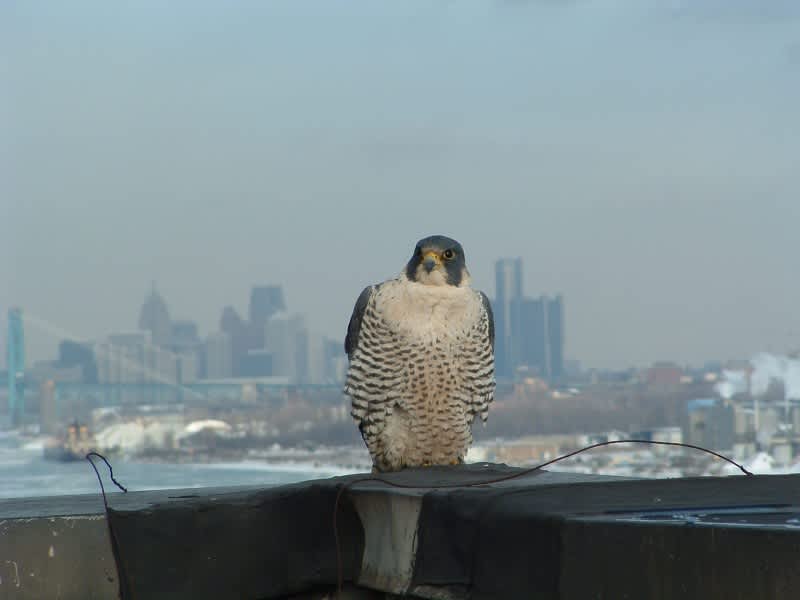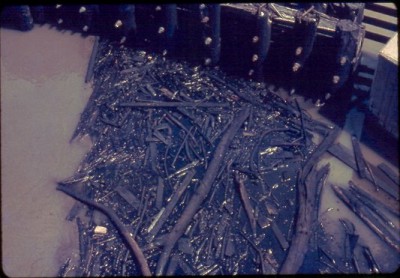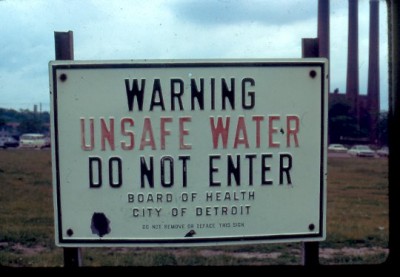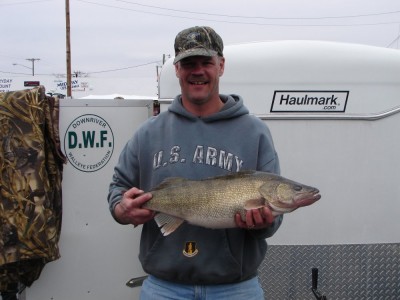Good News in Ecology: The Detroit River Revival
James Swan 05.31.13

Recently the U.S. Environmental Protection Agency (EPA) released the 2008-2009 National Rivers and Stream Assessment Survey about the quality of waterways in the U.S. gathered from approximately 2,000 sites across the country. Some of the findings include:
- Twenty-one percent of the nation’s rivers and streams are in good biological condition, 23 percent are in fair condition, and 55 percent are in poor condition.
- Twenty-seven percent of the nation’s rivers and streams have excessive levels of nitrogen, and 40 percent have high levels of phosphorus.
- Approximately 24 percent of the rivers and streams monitored were rated poor due to the loss of healthy vegetative cover.
- High bacteria levels were found in nine percent of stream and river miles making those waters potentially unsafe for swimming and other recreation.
- More than 13,000 miles of rivers have fish with mercury levels that may be unsafe for human consumption.
This is all important information and cause for concern, BUT, a couple things to take into account when you read something like this are: 1) Is this better or worse than things were before Earth Day 1970? and 2) Is one reason for any increases in problems better research methods and/or equipment rather than a new development?
Aside from the Daily Show with John Stewart and The Colbert Report, how often do you read, hear or watch any news reporting about something positive, especially something associated with ecology or the environment (with the exception of OutdoorHub, of course)?
We are bombarded daily with fresh tales of woe, corruption, scandal, crime, controversy, and disaster. One consequence is what Gerhardt Wiebe, Dean of the School of Journalism at Columbia University, called “well-informed futility.” And “green well-informed futility” is an especially virulent strain.
The EPA has asked for comments on the report. This article collects mine.

A polluted foundation
I don’t want to downplay the EPA study. It’s important we know what’s going on. If our rivers are in such bad shape, something needs to be done about it. But too much doom and gloom without something positive to balance it is not good for morale or the soul. I want to tell you about some ecological good news.
At an average rate of 175,000 cubic feet per second, the Detroit River surges through a strait less than a mile wide for 31 miles, passing more than four million people as it flows between Lake Saint Clair and Lake Erie. As it enters Lake Erie, the fertile waters slip past two cigar-shaped islands. Along the Canadian shore lies 2.5-mile-long Bois-Blanc Island, a former amusement park that today is a resort community. To the west in American waters is 12-mile-long cigar-shaped island, Grosse Ile, the quiet home of more than 12,000 people. I grew up on Grosse Ile.
When I was about five, I caught my first fish, a bright little saucer-sized pumpkinseed sunfish that I pounced on once my bamboo pole had carried it from the water to the bank. With ceremony we cleaned and cooked my first catch that night. I was filled with great pride as I took my first bite, only to spit it out immediately with revulsion.
“Got a bone in it?” my father asked.
“No,” I replied, “it tastes like oil.”
He took a bite and also spit it out. “Too bad,” he said, “never used to taste that way in the old days. It’s because of things they dump in the river.”
A history of the Detroit River reveals how becoming “civilized” has influenced water quality. Each winter in the 1700s the hay, straw, and manure from all the stables in Detroit was hauled out onto the frozen river and dumped on the ice. Spring thaws would then carry away downstream and into Lake Erie like one giant flush of the city’s toilet. This horse manure added to the growing flow of human sewage and other organic wastes.
As Detroit grew from a trading post into a city, the dumping increased. The records for the Detroit City Council for 1823 read, “Mr. Peter Berthelet was authorized to build a wharf from the shore out to deep water and install a pipe to supply water that would be free from contamination by the debris commonly dumped into the river.”
By 1909 the pollution of the Detroit River had become so bad that an International Joint Commission of representatives from the United States and Canada was formed to look into the problem. They reported four years later that both sides were dumping untreated sewage into the river. The U.S. and Canada acknowledged the pollution and its sources, and an agreement was reached to build some sewage treatment plants. A 1929-30 follow-up study concluded the river was no longer polluted to a harmful degree. My father, who was born in 1901 and lived nearly all his life on Grosse Ile, confirmed this. He recalled how before they dove off the bridge on the west side of the island he and his friends used to be able to see the bottom of the river.
The treatment of domestic wastes gave the river a temporary reprieve, but as Henry Ford’s dream materialized, the quality of water downstream from the automobile capital of the world declined again.

Waste resurgence
Fueled by World War II and our growing love for the automobile, swarms of immigrant families from Europe, the American South, and Appalachia arrived in waves and settled in suburbs around the Ford plant. The local economy grew but industrial and domestic sewage flowed into the river in worsening levels. A 1946-48 International Joint Commission examination of the Detroit River reported that it was seriously polluted by some 1,739,120,040 gallons of municipal and industrial wastewaters that flushed away on an average day! During 1950-55, the U.S. Department of Health, Education, and Welfare reported oil slicks on the river one-third of the time in spring and winter. Once abundant species, such as whitefish, blue pike, trout, and sturgeon, virtually disappeared from the Detroit River and Lake Erie, and those remaining often tasted oily.
In earlier times typhoid fever and cholera sometimes swept through the Detroit area due to sewage-laced drinking water. But with chlorination, no one was dying from water pollution in the 1940s. Major public-access sites and bridges displayed warning signs, announcing that the river was a public health hazard. You could still catch fish from the bank, but not the same rich assortment of prime species as a few decades earlier, and they often tasted like oil.
Two decades later, an infusion of nitrates and phosphates then commonly used in household detergents stimulated the growth of aquatic plants in the river and lake. These aquatic plants became so luxuriant that in mid-summer that boating was impossible in large areas. And as the plants died off in the fall, large amounts of vegetative material sank to the bottom, covering the bottom with a thick mat of rotting ooze. In the late fifties through the late sixties, large areas of the river and lake became biological deserts for all but carp and goldfish, which flourished. The Detroit River and Lake Erie were dying, but most people seemed unconcerned, in part because there was no clear and present danger. As the local economy prospered, with little or no protest, the Detroit River became a sacrifice in the name of prosperity.
A 1964 International Joint Commission report declared that the lower 26 miles of the Detroit River were now “polluted bacteriologically, chemically, physically, and biologically so as to interfere with municipal water supplies, recreation, fish and wildlife propagation, and navigation.” The water was so bad that the intake pipe near Wyandotte for pulling drinking water from the river was closed, and drinking water for the Detroit Metro Area was now piped in from Lake St. Clair upstream. In the 1950s, we used to buy Canadian fishing licenses and fish for perch, walleye, and bass on the Canadian side of the Detroit River just north of Bob-Lo Island, as fish caught on the American side all tasted like oil.
Wildlife biologist Dr. George Hunt, one of my professors at the University of Michigan and a duck hunting companion, estimated that as many as 10,000 ducks, geese, swans, and gulls used to die nearly every winter in the lower Detroit River. The worst damage occurred in the dead of winter when the river would freeze partially. Wastewater discharges were warmer, opening holes in the ice. Into those pockets of open water would stream flocks of migrating waterfowl, settling right into the worst oil slicks.
Little wonder that in 1970 a cover story on Time magazine declared Lake Erie dead.
On October 9, 1969, sparks from an acetylene torch ignited oil-soaked debris near an I-75 bridge, sending flames 50 feet in the air. Ten pieces of equipment and 65 firemen were required to put the blaze out and suddenly the Rouge River (which flows into the Detroit River) was a national media sensation.
The Rouge River fire was not alone. The Buffalo River in New York caught fire in 1968, as did the Chicago River in Illinois. The Cuyahoga River in Cleveland, Ohio, caught fire numerous times but was most famous for its fire in 1969.

Steps toward restoration
While previous fires in these four rivers had drawn local attention, because Earth Day 1970 was brewing, burning rivers suddenly became poster children for the new environmental movement, and serious efforts began to not only prevent future fires, but to restore these rivers to their original state.
Since then, the water and air in the Detroit area are a lot cleaner than they were and it’s time for reflection on the Rouge River and the other rivers of the Great Lakes that were once so horribly polluted. For a current report on the status of the Detroit River, I contacted Dr. John Hartig, Manager of the Detroit River International Wildlife Refuge in the lower Detroit River all around Grosse Ile (the only international wildlife refuge in the U.S.).
A life-long resident of southeastern Michigan, John grew up in Allen Park in the 1960s, and would pedal his bike down Southfield Road to fish the Detroit River. When he would come back home, “The neighbors would say, ‘You’re not going to eat that fish are you?’” Hartig recalls.
Dr. Hartig, a limnologist and former professor at Wayne State University, presides over an area that once was an epicenter for water pollution in the U.S., and the world for that matter. Have things changed? This is what he reports:
Evidence of ecological recovery
| Species | Evidence of recovery |
| Bald eagles | Nearly complete reproductive failure in the 1970s; in 2013, there were 18 active bald eagle nests in Wayne and Monroe counties in the vicinity of the Detroit River International Wildlife Refuge, after a 25-year absence |
| Peregrine falcons | Falcon population in Michigan was decimated in the 1950s; falcons were reintroduced in Detroit in 1987; since the early 1990s falcon reproductive success has steadily increased until this species was removed from Endangered Species list in 1999; expanded their range in recent years to Windsor under the Ambassador Bridge |
| Osprey | In 2009, a pair of osprey built a nest in a cell phone tower adjacent to the Gibraltar Wetlands Unit of the Detroit River International Wildlife Refuge, representing the first time that osprey have successfully nested in Wayne County since the 1890s |
| Common terns | Since the early 1960s there has been a 96 percent decline in nesting pairs along the Detroit River; in 2012 two common terns fledged (i.e., reached sufficient growth and development to be able to fly) from the restored Belle Isle habitat on Belle Isle, representing the first island fledging success since the 1960s |
| Lake sturgeon | No sturgeon spawning was recorded in the Detroit River from 1970s to 1999; in 2001 sturgeon reproduction was documented for the first time in 30 years on the U.S. side near Zug Island; in 2009 sturgeon reproduction was documented for the first time in 30 years near Fighting Island on the Canadian side of the river |
| Lake whitefish | Substantial decline in whitefish population between the late 1800s and early 1900s; in 2006 whitefish spawning in the Detroit River was documented for the first time since 1916 |
| Walleye | The walleye population in Lake Erie was rated as in “crisis” in 1978; it increased through the late 1980s and then has shown high year-to-year variability since the early 1990s; in 2012, fishery biologists estimated that 22.2 million walleye (age two and greater) were present in Lake Erie, resulting in a total harvest of 2.48 million walleye through sport and commercial fishing; an estimated 10 million walleye ascend the Detroit River from Lake Erie each spring to spawn creating an internationally renowned sport fishery; the Detroit River and Lake Erie are considered the “Walleye Capital of the World” and attract major international fishing tournaments |
| Beaver | Beaver were hunted to near extinction during the “fur trade era;” during the height of oil pollution in the 1940s-1970s, beaver could not have survived in the Detroit River because oiled fur becomes matted and they lose their ability to trap air and water to maintain body temperature; loss of riparian forest habitat was another contributing factor; in 2008, two beaver built a lodge at DTE’s Conner Creek Power Plant; in 2009, this pair produced at least two pups; beaver have continued to be seen through 2012; beaver have also been reported from the headwaters of the Rouge River, in the Rouge River near University of Michigan-Dearborn, and at Crosswinds Marsh; in 2013, beaver were seen at DTE’s Rouge Power Plant |
| Mayflies | Few mayflies present in western Lake Erie between 1950s and 1992; mayflies increased between 1997 and 2004 being rated “good” to “excellent” since 2002 |
| Wild celery | Wild celery tuber (an important food for diving ducks) abundance at selected stations in the Detroit River declined 72 percent between 1950-1951 and 1984-1985 because of oil and other pollution, and increased 200 percent between 1984-1985 and 1996-1997 due to pollution controls and increased water clarity |
I would add that when I was growing up on Grosse Ile, I saw one deer on the island during the 18 years before I left for college. This year there was a deer season on the refuge.
Perhaps even more astounding is the current Michigan DNR fishing report that talks about steelhead in the Huron River. There were carp and catfish in the Huron River in my days back there, but steelhead! In the 1960s a paper company in Ypsilanti poured dyes into the river so the river changed color every day.
Dr. Hartig has recently published a most-important book that chronicles the near-death and rebirth of these four Great Lakes Rivers that caught fire–the Rouge, Cuyahoga, Buffalo and Chicago. Burning Rivers: Revival of Four Urban-Industrial Rivers that Caught on Fire traces the history of each river, showing its worst days when the predominant organisms were sludge worms and the rivers were flowing health hazards, to how they each have been restored, providing recreational opportunities with over 50 species. The ultimate message is one of hope that deserves widespread reading.
If you know someone who suffers from “green well-informed futility,” buy a copy of Burning Rivers and give it to them. This book is powerful medicine.
And if you want to go fishing for walleyes, the Detroit River and Lake Erie have become the walleye capital of the world (I understand that perch and smallmouths are doing pretty well, too).
So, EPA, keep up the good work. Make sure we don’t ever slide back to having rivers catch fire. But, please don’t forget to inject some good news into your reports to remind people that pollution problems can be solved for wildlife and people’s benefit.

Editor’s note: Check out our Pure Michigan page for more information on great Michigan fishing–particularly on the Detroit River.

